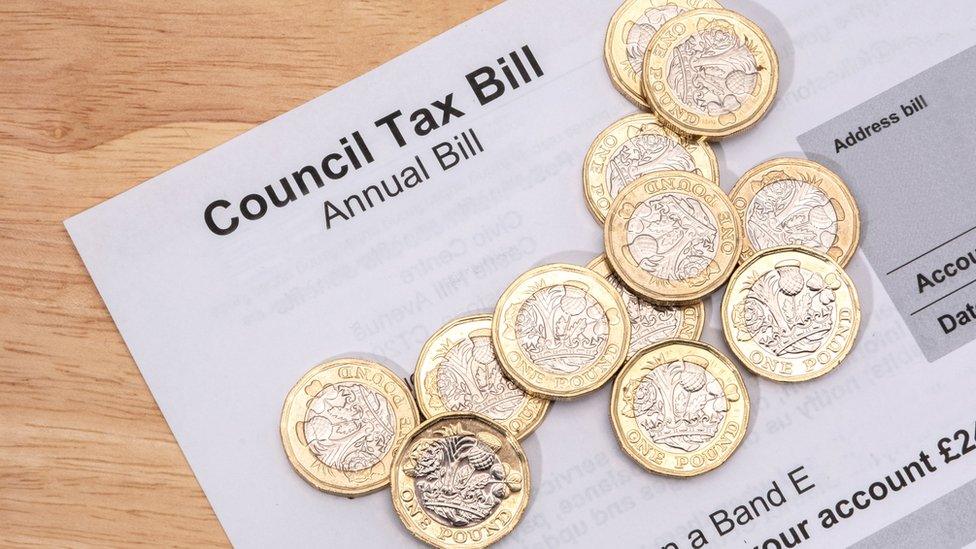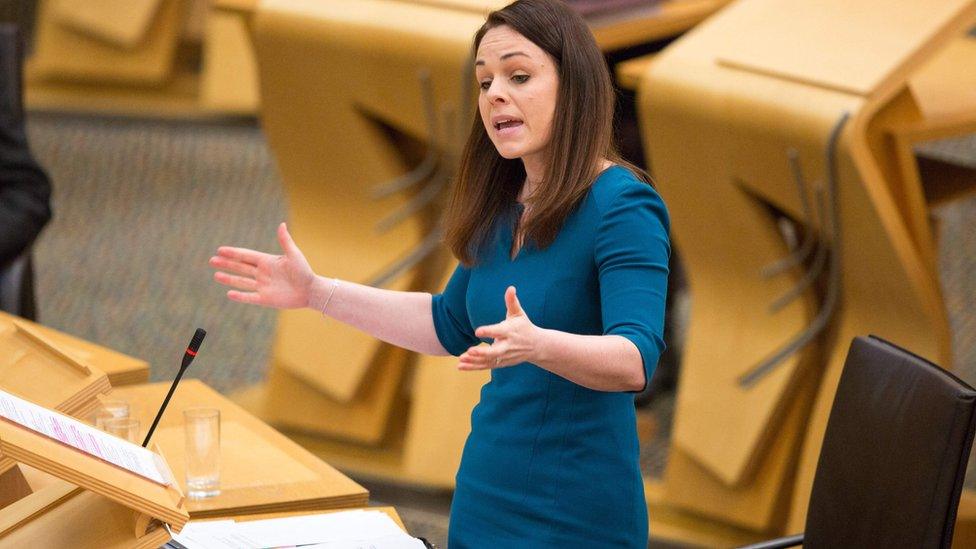Holyrood’s budget: Big vision, tight squeeze
- Published

Kate Forbes budget speech was big on inequality; climate change spurred on by Green ministers; and business support, even though business was underwhelmed
The other side of the budget was the Scottish Fiscal Commission report, highlighting sluggish tax receipts, growing block grant cuts, risky assumptions of income not yet secured, and the challenge of funding big ambitions for more generous benefits
How, then, can ambitious spending plans be funded? More economic growth? Wellbeing? Independence?
There were two budget documents published on Thursday in Edinburgh: one in the chamber of the Scottish Parliament, the other in the old prison governor's residence on Calton Hill.
That is home to the Scottish Fiscal Commission, the independent body that scrutinises the state of the economy, of Holyrood's tax revenue prospects and of its spending plans.
Its report - published, as required, as Kate Forbes sat down - told a rather different story from her speech to MSPs.
That speech set out grand and uncontroversial themes: tackling inequality as it affects families and young people, helping Scotland make its contribution to reducing climate change, and helping businesses recover from the pandemic.
The last of these left businesses underwhelmed. On the same afternoon the budget was announced, Public Health Scotland was advising people to cancel or avoid Christmas parties - the hospitality trade was not toasting the finance secretary with gratitude.
"Avoiding the cliff edge" of a sudden return to paying business rates after two years without them, with a 50% rebate for three months, looks like a different cliff in summer weather.
The green theme avoided giving Green ministers all the credit, but their influence could be seen, beyond the headlines of their partnership deal promising more free bus travel and a minimum share of the transport budget.
Better building insulation was getting much more serious amounts of money. And while hospitality, tourism and leisure were getting that postponement of their business rates cliff edge, aviation was being pushed off the precipice next April, without any further support, in the hope that it can fly.
The aviation industry is further from a full return to financial airworthiness than any other, and you can safely assume that Green MSPs prefer to see it that way.
And support for low income families and children? If there's one policy that gets Nicola Sturgeon out of bed in the morning, it is probably this. And in the breadth and depth of funding announced by her finance secretary, with a big boost to child benefit payments, it shows.
Cuts and squeezes
But giving away more money, without securing the tax base to afford it, is also one of the themes of Nicola Sturgeon's government - at least if the Scottish Fiscal Commission (SFC) is any guide.
It offered Kate Forbes a very much rosier scenario than it did at her last draft budget, in January. Growth for the current financial year is now forecast at a sizzling 10.4%. Unemployment is set to peak at a remarkably low level of 4.9%.
That's where the good news stopped. Deploying the block grant increases announced and implied by Chancellor Rishi Sunak, the SFC projected budget growth of 10% during this Holyrood term.
That's in cash terms. In real terms, the budget is set to decline for a couple of years before recovering to a five-year increase of a startlingly weak 1%.
There are so many pledges, continuing commitments and expectations coming out of the SNP's election win last May, and from its partnership deal with Greens. There are pressures, too, to transform the economy and households to net-zero carbon, and to meet the health and social care demands of demographic change (that is, more older people, fewer tax-paying ones).
Yet there's only 1% more to meet those commitments, expectations and pressures.

The SFC highlighted only one area of this term's budgeting that goes unfunded. Having gained powers over many benefits, the Scottish government gets a grant of what would be spent if Scots continued to have UK benefit rules applied.
The Scottish government wants to be more generous, not only to children, but also to disabled adults from next year.
The SFC reckoning is that the package will be £750m per year more generous. None of that is funded, and with a balanced budget requirement, it implies cuts and squeezes elsewhere.
And how is that budget balanced next year?
It includes £620m of funds that Kate Forbes hopes the Treasury will release, if past practice is any guide, plus an assumption that Scottish ministers will win a four-year dispute with the Treasury over the block grant calculation, plus a windfall of cash from the Scotwind auction of sea areas for wind farm developments.
The SFC report is cautious about such bold optimism that all those funds will materialise, but concludes the assumptions are at least "reasonable".
Flight of top earners
Surely, you ask, any gaps in funds could be paid for through a hike in income tax, over which Holyrood now has most controls? Well, yes, it could raise tax rates and revenue, but no, it's not raising enough to offset a drop in the block grant from Westminster.
This is complicated, but important. To over-simplify, Holyrood gets a block grant from the Treasury based on a long-standing formula. For 43 years, any additions to English spending brought a "consequential" addition to the grants for Scotland, Wales and Northern Ireland.
But with income tax powers shifted to Holyrood, the Treasury deducts the amount it would have raised under UK tax rates and rules. This is the Block Grant Adjustment (BGA).
The implication: if Holyrood gets the economy and tax base growing at the same pace and if it applied the same rules, it would raise the same amount.
However, if growth of the Scottish economy and its income tax base fall behind that of the rest of the UK, then it won't be able to plug that gap. This power is also an incentive to do better: if Scotland grew its economy faster, Holyrood would get the tax revenue benefits.
For now, it's growing more slowly - so much so that the additional funds raised by higher Scottish tax rates do not offset the BGA drop. The net gap next financial year is £190m, rising to a shortfall of £417m in 2026-27.
Could that be because of a flight out of Scotland of higher rate tax-payers or at least their income, taking revenue with them? Yes, it could, but not on this reckoning. Without those higher tax rates, the SFC says the gap would be £1.1bn by 2026.
Growth or wellbeing?
So what is to be done? Faster economic growth, higher value industries, a productivity boost, more people joining the workforce - if not through immigration (controlled from Whitehall, though not the internal UK variety) then through incentives to bring young, old and all the genders into the workplace.
And yet this is a time when the Scottish government is downplaying growth in favour of "wellbeing".
For many, the answer lies in the additional powers that would come with Scottish independence.
They can look to the SNP's Growth Commission for guidance on how to boost productivity and how to use the tax system to stimulate growth.
They can look, but they won't find much, as the commission's report - now party policy - doesn't conclude much on these. Only that they would have to be addressed.
The main analysis asserts that a selection of smaller independent countries can grow faster, and that if others can, why not Scotland?
The question sounds rhetorical, but a different question, "HOW could Scotland?" does not have easy or simple answers.
- Published9 December 2021

- Published9 December 2021

- Published9 December 2021

